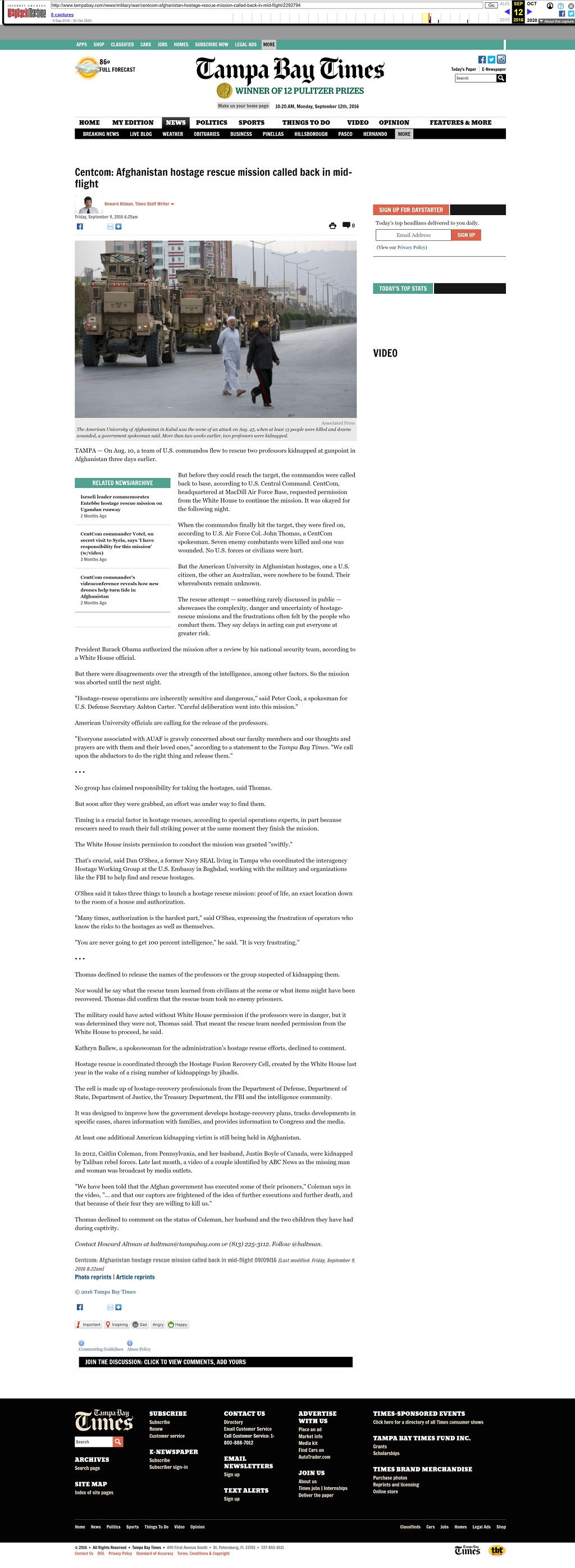
News / Military
By Howard Altman / Tampa Bay Times / September 9, 2016
PHOTO: The American University of Afghanistan in Kabul was the scene of an attack on Aug. 25, when at least 13 people were killed and dozens wounded, a government spokesman said. More than two weeks earlier, two professors were kidnapped. (Associated Press)
TAMPA — On Aug. 10, a team of U.S. commandos flew to rescue two professors kidnapped at gunpoint in Afghanistan three days earlier.
But before they could reach the target, the commandos were called back to base, according to U.S. Central Command. CentCom, headquartered at MacDill Air Force Base, requested permission from the White House to continue the mission. It was okayed for the following night.
When the commandos finally hit the target, they were fired on, according to U.S. Air Force Col. John Thomas, a CentCom spokesman. Seven enemy combatants were killed and one was wounded. No U.S. forces or civilians were hurt.
But the American University in Afghanistan hostages, one a U.S. citizen, the other an Australian, were nowhere to be found. Their whereabouts remain unknown.
The rescue attempt — something rarely discussed in public — showcases the complexity, danger and uncertainty of hostage-rescue missions and the frustrations often felt by the people who conduct them. They say delays in acting can put everyone at greater risk.
President Barack Obama authorized the mission after a review by his national security team, according to a White House official.
But there were disagreements over the strength of the intelligence, among other factors. So the mission was aborted until the next night.
“Hostage-rescue operations are inherently sensitive and dangerous,” said Peter Cook, a spokesman for U.S. Defense Secretary Ashton Carter. “Careful deliberation went into this mission.”
American University officials are calling for the release of the professors.
“Everyone associated with AUAF is gravely concerned about our faculty members and our thoughts and prayers are with them and their loved ones,” according to a statement to the Tampa Bay Times. “We call upon the abductors to do the right thing and release them.”
No group has claimed responsibility for taking the hostages, said Thomas.
But soon after they were grabbed, an effort was under way to find them.
Timing is a crucial factor in hostage rescues, according to special operations experts, in part because rescuers need to reach their full striking power at the same moment they finish the mission.
The White House insists permission to conduct the mission was granted “swiftly.”
That’s crucial, said Dan O’Shea, a former Navy SEAL living in Tampa who coordinated the interagency Hostage Working Group at the U.S. Embassy in Baghdad, working with the military and organizations like the FBI to help find and rescue hostages.
O’Shea said it takes three things to launch a hostage rescue mission: proof of life, an exact location down to the room of a house and authorization.
“Many times, authorization is the hardest part,” said O’Shea, expressing the frustration of operators who know the risks to the hostages as well as themselves.
“You are never going to get 100 percent intelligence,” he said. “It is very frustrating.”
Thomas declined to release the names of the professors or the group suspected of kidnapping them.
Nor would he say what the rescue team learned from civilians at the scene or what items might have been recovered. Thomas did confirm that the rescue team took no enemy prisoners.
The military could have acted without White House permission if the professors were in danger, but it was determined they were not, Thomas said. That meant the rescue team needed permission from the White House to proceed, he said.
Kathryn Ballew, a spokeswoman for the administration’s hostage rescue efforts, declined to comment.
Hostage rescue is coordinated through the Hostage Fusion Recovery Cell, created by the White House last year in the wake of a rising number of kidnappings by jihadis.
The cell is made up of hostage-recovery professionals from the Department of Defense, Department of State, Department of Justice, the Treasury Department, the FBI and the intelligence community.
It was designed to improve how the government develops hostage-recovery plans, tracks developments in specific cases, shares information with families, and provides information to Congress and the media.
At least one additional American kidnapping victim is still being held in Afghanistan.
In 2012, Caitlin Coleman, from Pennsylvania, and her husband, Justin Boyle of Canada, were kidnapped by Taliban rebel forces. Late last month, a video of a couple identified by ABC News as the missing man and woman was broadcast by media outlets.
“We have been told that the Afghan government has executed some of their prisoners,” Coleman says in the video, “… and that our captors are frightened of the idea of further executions and further death, and that because of their fear they are willing to kill us.”
Thomas declined to comment on the status of Coleman, her husband and the two children they have had during captivity.
Wayback image

